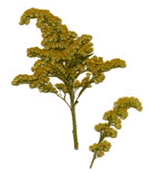
Goldenrod
Introduction
This fact sheet provides basic information about Goldenrod. In folk medicine, goldenrod was used to treat such diverse conditions as rheumatism, gout, diabetes, hemorrhoids, internal bleeding, enlarged prostate, asthma, enlarged liver, tuberculosis, mouth and throat infections, and festering wounds. Unfortunately, its effectiveness for treating these conditions has never been proven.
Common Names
Goldenrod
Latin Names
Solidago virgaurea
What It Is Used For
- Bladder inflammation
- Arthritis
- Allergies
- Colds and flu
- Kidney stones
- Laryngitis (as a gargle)
- Sore throats (as a gargle)
- Goldenseal may also be used as a topical application to aid in healing injuries and skin conditions such as eczema.
How It Is Used
While there is not an official recommended dosage the follow are typical dosages:
- Tea - Mix 2 - 3 teaspoons of dried herb in 1 cup of water, bring to a boil, and let sit for 10 to 15 minutes; strain and drink. Take three times per day.
- Gargle - Make the tea described above, and gargle with it three times per day.
- Liquid extract - (1:1) in 25 ethanol: Take 0.5 to 2 mL two to three times per day.
- Tincture - (1:5) in 45 ethanol: Take 2 to 4 mL two to three times per day..
What the Science Says
- There is a lack of clinical evidence to support the use of goldenrod for any indication.
Side Effects and Cautions
- Most people believe that goldenrod is generally considered safe and has no known side effects. However, you should not use this herb if you have impaired heart or kidneys.
- Information regarding safety and efficacy in pregnancy and lactation is lacking. Avoid use.
Sources







